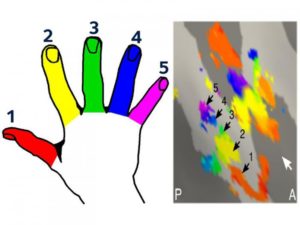 Researchers discovered that while our brains have a detailed picture of our hands and fingers, this representation in the brain is maintained, in some cases, for as long as 3 decades after an amputation.
Researchers discovered that while our brains have a detailed picture of our hands and fingers, this representation in the brain is maintained, in some cases, for as long as 3 decades after an amputation.
“It has been thought that the hand ‘picture’ in the brain, located in the primary somatosensory cortex, could only be maintained by regular sensory input from the hand,” says team leader Dr. Tamar Makin.
“In fact, textbooks teach that the ‘picture’ will be ‘overwritten’ if its primary input stops. If that was the case, people who have undergone hand amputation would show extremely low, or no activity related to its original focus in that brain area- in our case, the hand,” she adds.
Dr. Makin notes that people with amputations have been known to experience phantom sensations from the amputated body parts to the extent that if they are asked to move a finger, they can “feel” the movement.
The objective of the research was to examine information that underlies brain activity in phantom movements in amputees to observe how it varied from the brain activity of people moving actual hands and fingers.
Brain activity of amputees matched two-handed controls
Dr. Makin, associate professor and Sir Henry Dale fellow, and the team of the Hand and Brain Lab at the University of Oxford used an ultra-high power (7T) MRI scanner to look at brain activity in amputees.
Participants included two individuals who experienced phantom sensations 25 and 31 years after their left hands were amputated and a control group of 11 right-handed people who had all limbs intact.
Each person was asked to move individual fingers on their left hand. “We found that while there was less brain activity related to the left hand in the amputees, the specific patterns making up the composition of the hand picture still matched well to the two-handed people in the control group,” says study leader Sanne Kikkert.
“We confirmed our findings by working with a third amputee, who had also experienced a loss of any communication between the remaining part of their arm and their brain. Even this person had a residual representation of their missing hand’s fingers, 31 years after their amputation,” she adds.
One of the amputees, Chris Sole – who has taken part in a number of studies – was chosen for this study as he still experiences a strong sense of movement in his hand that was amputated in 1989. “You feel like you can move your fingers and you have individual control,” explains Sole.
“I am always happy to take part in this team’s studies, especially if it can help other people. The more they can learn, the better,” he says.
Original function area of brain not erased after amputation
Previously, scientists have studied representations of the unaffected limbs in amputees to observe brain changes. However, this approach does not explore if any of the original function of the brain – concerning the lost limb – is preserved and lays dormant.
The new study sheds light on the brain’s ability to adapt to new circumstances and how the brain reacts once an essential body part is lost. The findings observed in amputees who experience phantom sensations show that despite a drastic change in inputs, the brain maintains the activity of the missing parts of the body.
While the study leads to new understanding and awareness of the brain’s ability to change, the findings are consistent with other studies of the brain’s visual cortex, which uncovered that degenerative eye disease that limits visual input does not modify the brain’s representation of the patient’s field of vision.
“It seems that even, as previously thought, the brain does carry out reorganization when sensory inputs are lost, it does not erase the original function of a brain area.”
Sanne Kikkert
Kikkert explains that the realization of this brain activity removes a barrier to neuroprosthetics – prosthetic limbs controlled directly by the brain – and the assumption that an individual loses the brain area that could control the prosthetic upon amputation.
“If the brain retains a representation of the individual fingers, this could be exploited to provide the fine-grained control needed,” she concludes.
MNT DT






